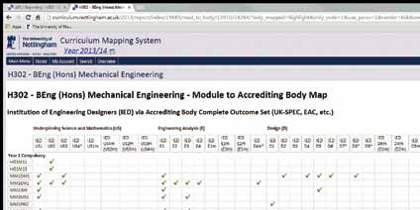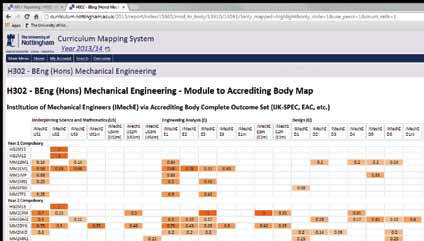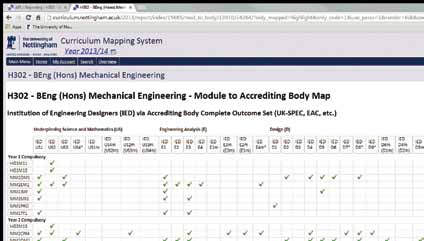
December 2, 2013, by Teaching at Nottingham
A faculty-wide mechanism for optimising teaching
Dr Kay Bond “In common with many units across the University, the Faculty of Engineering faces a number of significant challenges, amongst which maintenance of high quality teaching and excellent student experience in the face of efficiency savings rank highly. Additional, engineering-specific, challenges come from the need to respond positively and professionally to the demands of both national and international accrediting bodies. Whilst much of the impetus for this work came from the need for compliance with accrediting body requirements, the faculty recognised the opportunities that this presented in terms of alignment of learning outcomes, assessment and teaching. The benefits of this outcomes-based approach are much more far reaching …
- “Transparency – improving student motivation and encouraging independent learning through increased transparency of expectations.
- “Assessment and improved quality of feedback – being much clearer about what we expect from students and alignment of our feedback with those expectations (NSS …).
- “Assessment and efficiency – effective targeting of resources to avoid teaching and assessment duplication thus improving the learning and teaching experiences (student and staff workload …).
- “Curriculum coherence and mapping – in particular maintaining an overview of programme learning outcomes and their relationships to the modules where they are delivered and assessed, thus helping inform programme review activities where the implications of any changes to programme structures can be assessed quickly and accurately.
- “Accreditation – demonstrating to accrediting bodies that we both deliver and assess the requisite learning outcomes, and that they are being achieved by all our ‘accredited’ students.
- “International campuses – increasing integration with Malaysia and China campuses through the project itself and through the process of outcomes revision and curriculum mapping.
Clarifying learning outcomes
“There are many challenges and pitfalls associated with this kind of undertaking, however we avoided making assumptions about modules and disenfranchising staff from the process by asking module conveners to review their own teaching aims and values, before going on to identify how their contribution fits into the wider programme.
“We ran a series of workshops and drop-in consultations for engineering staff to cover writing module learning outcomes using Bloom’s taxonomy appropriate to the module level, linking module outcomes to programme level outcomes, and identifying which assessments addressed each module outcome. . Initially we particularly aimed these at champions with a view to them mentoring other staff through the process. We also provided a guide to writing and assessing learning outcomes.
“We aimed the sessions at getting staff to think about whether they were teaching with an outcomes or syllabus focus and to ask themselves:
- Why am I teaching this and why am I assessing this?
- How can I assess this and how can I measure the assessment against criteria?
- In what form do I think the feedback will be?
“There has been a noticeable culture change with most staff better equipped to identify the intended learning outcomes. Whether or not they agree with the approach, staff now readily converse using the language of learning outcomes and assessment.
Mapping the curriculum

how the learning outcomes for each module listed map to the accrediting
body’s requirement for the programme. In this example the programme is
H302 BEng (Hons) Mechanical Engineering and the accrediting body is the
Institution of Mechanical Engineers.
“The University curriculum mapping system, developed by the LRLR Learning Technologists in conjunction with Medicine and Nursing in particular, has been populated with the information generated from the process of identifying outcomes at module level. Many of the engineering modules appear in several different degree programmes, thus we have mapped our modules to the over-arching organisation’s (The Engineering Council UK) set of outcomes commonly known as UK-SPEC. Each individual accrediting body such as the Institution of Chemical Engineers (IChemE), the Institution of Mechanical Engineers (IMechE) or the Institution of Engineering Designers (IED) is also mapped to UK-SPEC thus any module (and set of modules, i.e. a programme) needs only be mapped once, yet a report can be produced to suit any of the engineering institutions.

in Figure 1, but this time for a different accrediting body (Institution
of Engineering Designers) who have slightly different requirements with
which the programme must demonstrate compliance.
“Figures 1 and 2 give a brief idea of the capability of the Curriculum Mapping System, however there is much more functionality in terms of mapping learning activities, sessions or lectures, programme outcomes rather than accrediting body, etc. The system is currently being used by Medicine, Nursing, Vets and Engineering with Pharmacy exploring the opportunity. The Curriculum Mapping System can be found at: curriculum.nottingham.ac.uk and is open for anyone to view the current data sets.
Ongoing developments
“The current phase involves linking the curriculum map to Moodle so that students can see their individual progression against the accrediting body outcomes. There is also some development work in some Departments to review assessment and how it can best measure achievement of programme outcomes and also support student learning.”
Dr Kay Bond
Faculty of Engineering
The curriculum mapping system can be accessed at http://curriculum.nottingham.ac.uk/ so you can look around what’s already there. You’ll need to contact the Staff IT Helpline to get access to set up your own programme and modules.
No comments yet, fill out a comment to be the first

Leave a Reply